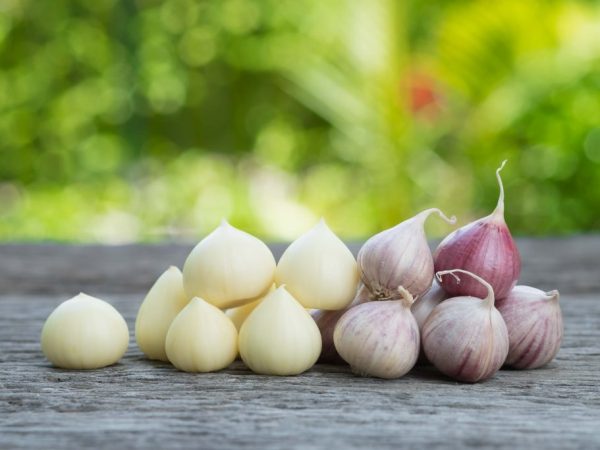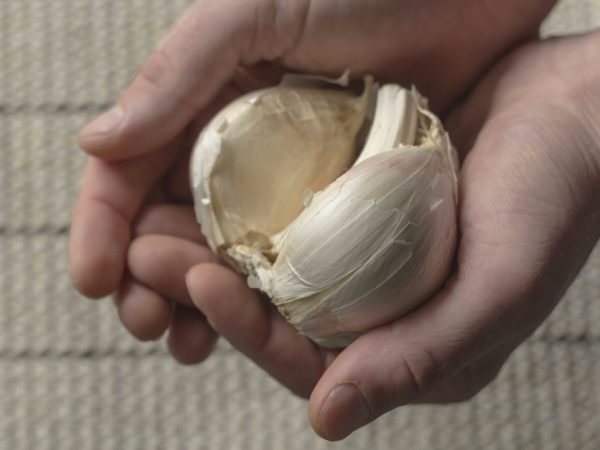Description of Elephant Garlic
Garlic is an invariable ingredient in a vast array of everyday and festive cuisine. Many people refuse to use it because of the pungency of the taste. There is a great alternative to it - an amazing vegetable, which in Russia and some European countries is called "rocambol". Its real name is elephant garlic.

Elephant garlic
Its size is really amazing - the weight of one head is about 200 grams, grown on fertile soils - up to 400 grams. One clove weighs 50-80 grams, there are 4-6 of them in the head.
Variety characteristic
Elephant garlic is called garlic, but it is actually a perennial plant in the onion family, a close relative of the leek. The homeland of this amazing culture is the Balkans. In the 40s of the 19th century, he was brought to America. Peru is now the world's largest supplier. In its natural environment, it is found in southern Europe, in the Crimea and the North Caucasus, in Central and Southeast Asia.
Description of the plant
Outwardly, the plant resembles a leek. Height 1.5-2 m (depending on growing conditions). The flower stalk is crowned with a lilac spherical inflorescence. The seeds usually do not ripen, but children are formed at the bottom of the bulb, which can be used to breed a crop.
Despite the great similarities between related plants, leeks and elephant garlic have many differences:
- Elephant garlic has a semi-pungent flavor and light garlic aroma;
- it is grown to form a head, not a white stem;
- the size of the head: it can hardly fit on the hand of an adult.
A common mistake of gardeners is growing on the basis of agricultural technology of ordinary garlic, but it is necessary on the basis of leeks.
Beneficial features
Elephant garlic has a yield that is 6 times higher than that of a conventional crop. Moreover, it has many positive properties:
- contains vitamins of group B, as well as C, E, K, PP;
- has antioxidant properties;
- its essential oil has an antibacterial, fungicidal, hypotensive, tonic effect.
Application
Doctors recommend elephant garlic for infectious and viral diseases. Its use helps to cope with anemia, problems of the gastrointestinal tract, blood vessels, is used to heal infected wounds, as well as in antihelminthic therapy.
The plant has found application in the culinary business for cooking meat dishes, sauces, snacks.
Features of agricultural technology
To get a good crop harvest, you need to take into account the following features:
- the soil should be well moistened, especially at a depth of 3-5 cm (mulching contributes to moisture retention);
- a significant increase in yield is provided by the introduction of organic matter, nitrogen-containing fertilizers.
Removing the peduncle does not lead to a significant increase in yield. At the same time, the number of "children" is increasing, therefore it is recommended to carry out such a procedure to obtain a large amount of planting material. Some of them remain in the soil and litter the organized plantings.The growing season of elephant garlic is 110-120 days.
Landing
You can plant elephant garlic in autumn and spring. The winter crop forms a larger head. However, in regions with cold winters, autumn plantings may freeze out.
Suitable soil is loose, well-manured. The site must be open and lighted.

With the right care, a good harvest
Autumn planting
The soil for planting winter elephant garlic begins to be prepared in August or September. Rotted manure is introduced (20-50 kg per 1 square meter), and in its absence, compost in much larger quantities. If the soil is loamy, make it lighter by adding sand and peat. However, the acidity is controlled: it should not be higher than 6.5-7.5. To reduce acidity, dolomite flour or fluff lime is scattered over the area.
Before planting, the teeth are treated with special preparations for crops of this family or in a solution of potassium permanganate (12 hours).
One way to land is in trenches. Their dimensions are: depth - 30 cm, width - 20-25 cm. Compost is placed in the trench. Teeth are planted on it and sprinkled with soil. This natural fertilizer can be supplemented with superphosphate or wood ash. Mulching with leaves of garden trees will protect the planting of elephant garlic from frost and take root in a timely manner. And with a short-term warming, the plants will not germinate. The recommended time for disembarkation is 3-4 weeks before frost.
Spring planting
They begin to prepare planting material for spring planting in advance: within three weeks they are "hardened" at a temperature of 3-5 ° C, then "green", keeping in the light for about a week.
The soil is prepared in winter. Before planting, it is either dug up again or loosened well. Planting is carried out early enough, as soon as the soil stably warms up to 6 ° C. The teeth are buried by 10-15 cm (depending on the size). The beds are mulching.
Care
After the emergence of seedlings, the beds of elephant garlic are watered with settled cold water so as not to provoke fungal diseases. The soil must not be allowed to dry out and be compacted, therefore watering and loosening must be regular.
The plant is responsive to subcortexes. It is recommended to fertilize the crop three times per season: after emergence (with ammonium nitrate); during active growth of green mass (organic matter and urea solution); at the time of head formation (with phosphorus-potassium fertilizers or wood ash).
The most common plant pests are onion fly and root mite. To combat them, use a mixture of ground pepper, ash and tobacco chips (process at least 2 times a month).
Storage
Harvesting is carried out, depending on the region, from the second half of August to mid-September. A sign of maturation is yellowed and lodged leaves. Elephant garlic is perfectly stored until February, subject to several conditions:
- for harvesting, you need to choose dry weather;
- after digging it up, dry it in a warm ventilated place, avoiding direct sunlight for a month;
- the next stage is pruning the dried leaves (leave the stump about 5 cm), while the bottom is not cut off.
Placed for storage in boxes on a soft bedding of straw or dry sawdust. Shelf life: at a temperature of 8 ° C - about 5 months, at room temperature - three.
Conclusion
The cultivation of elephant garlic has not yet become widespread in the post-Soviet space, this is facilitated by the difficult care and exactingness of the plant. It is difficult to find quality planting material.
The described properties and easy care can make elephant garlic one of the favorites of summer residents and gardeners. In addition, the plant is very decorative during the flowering period.


